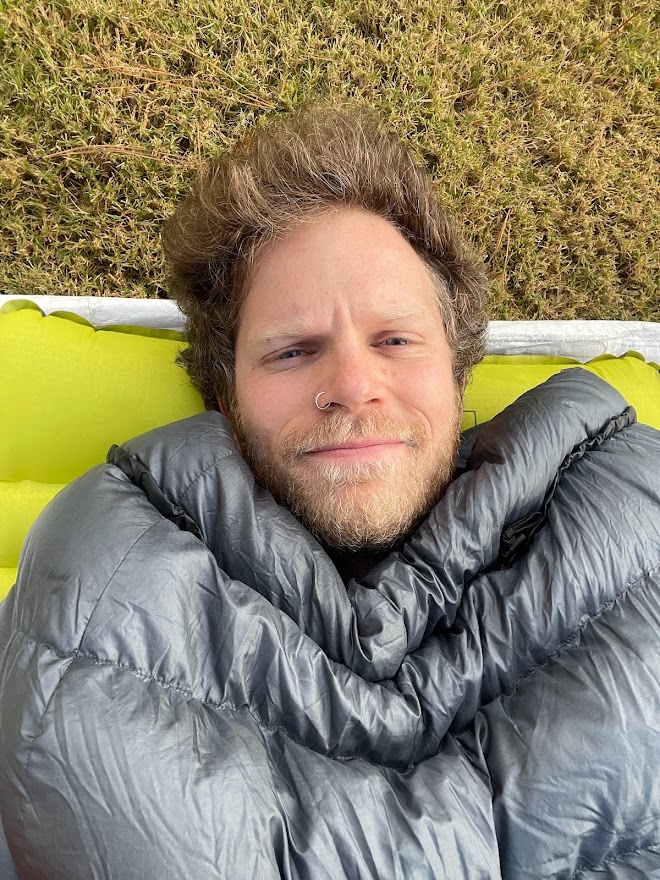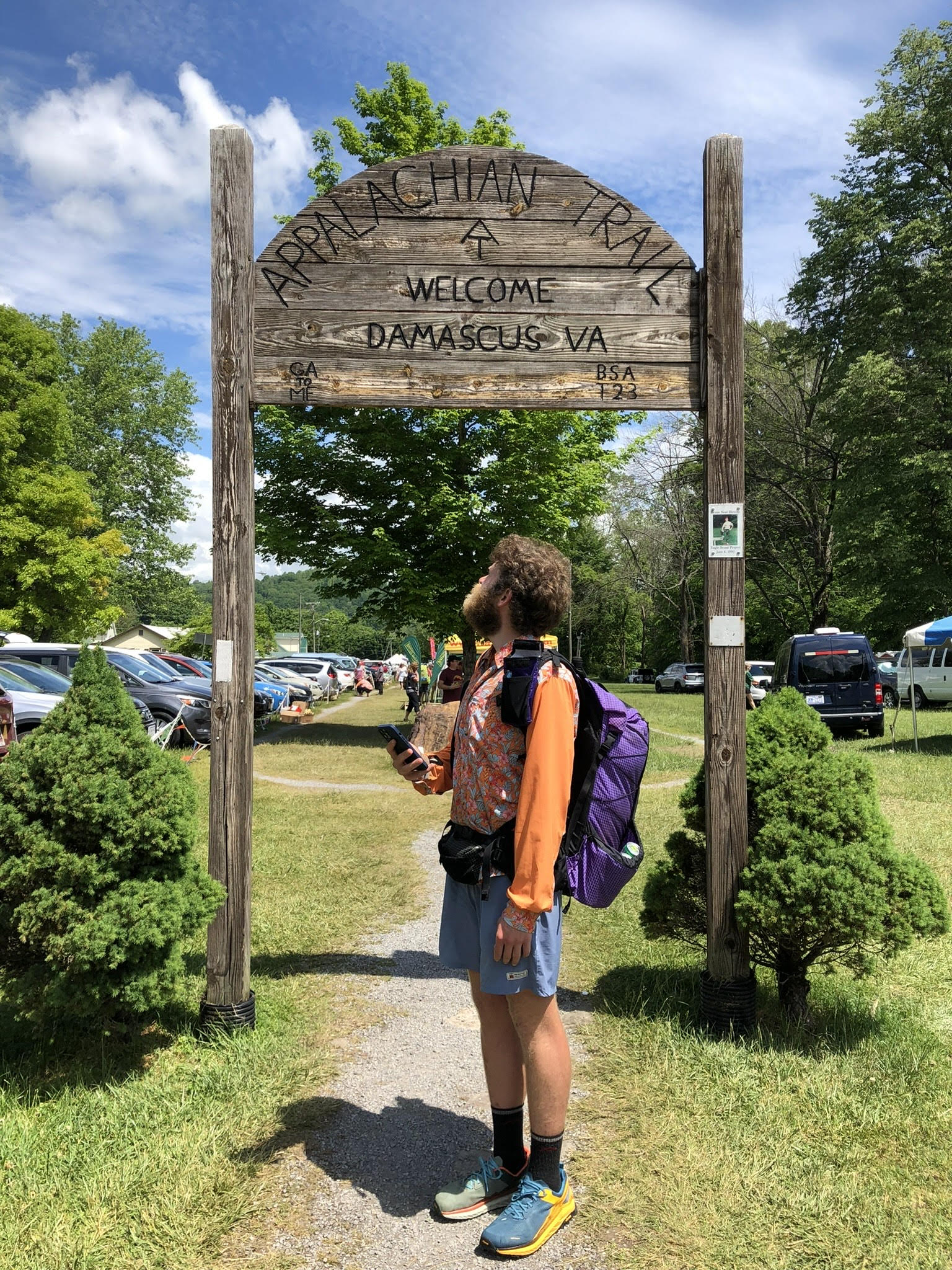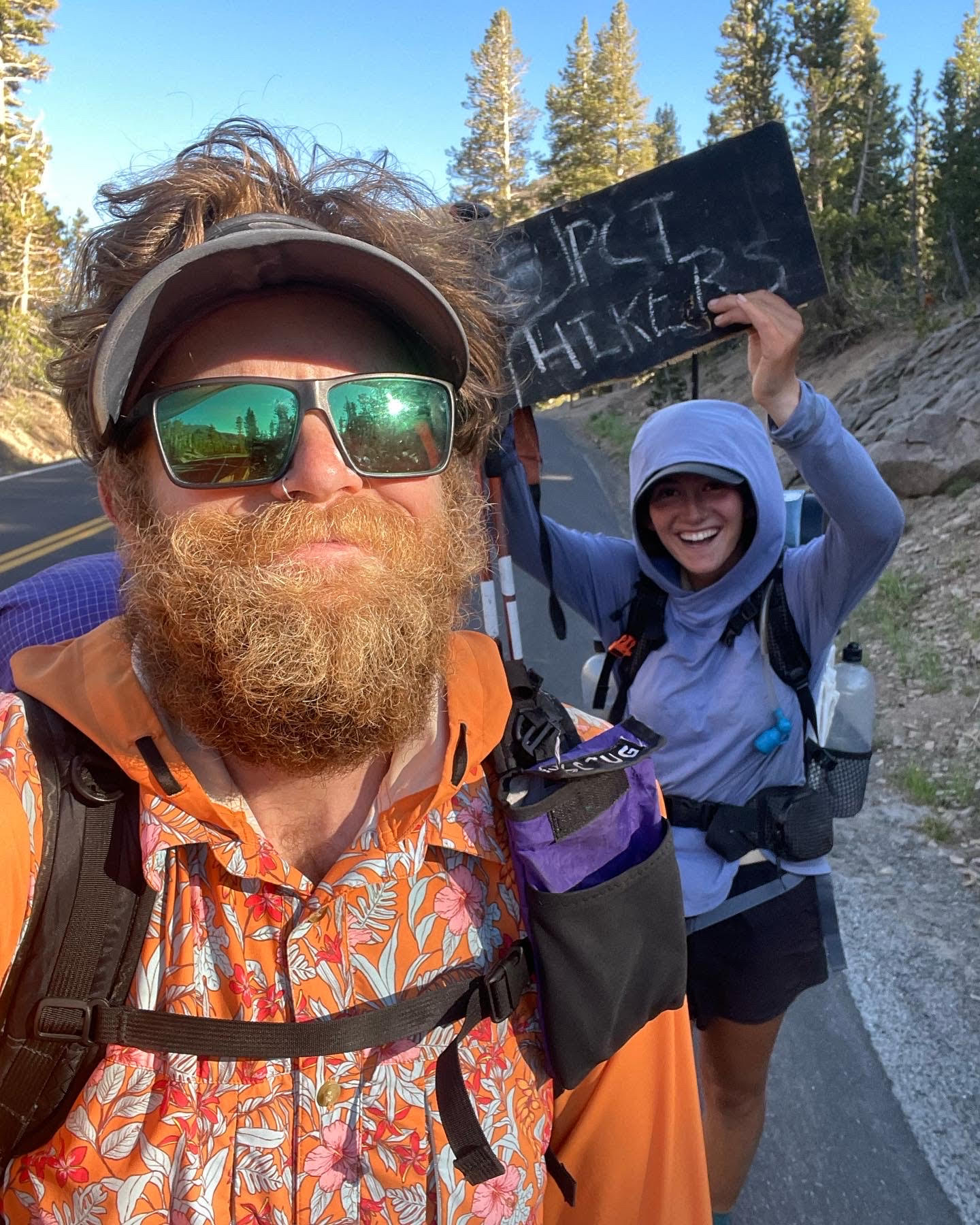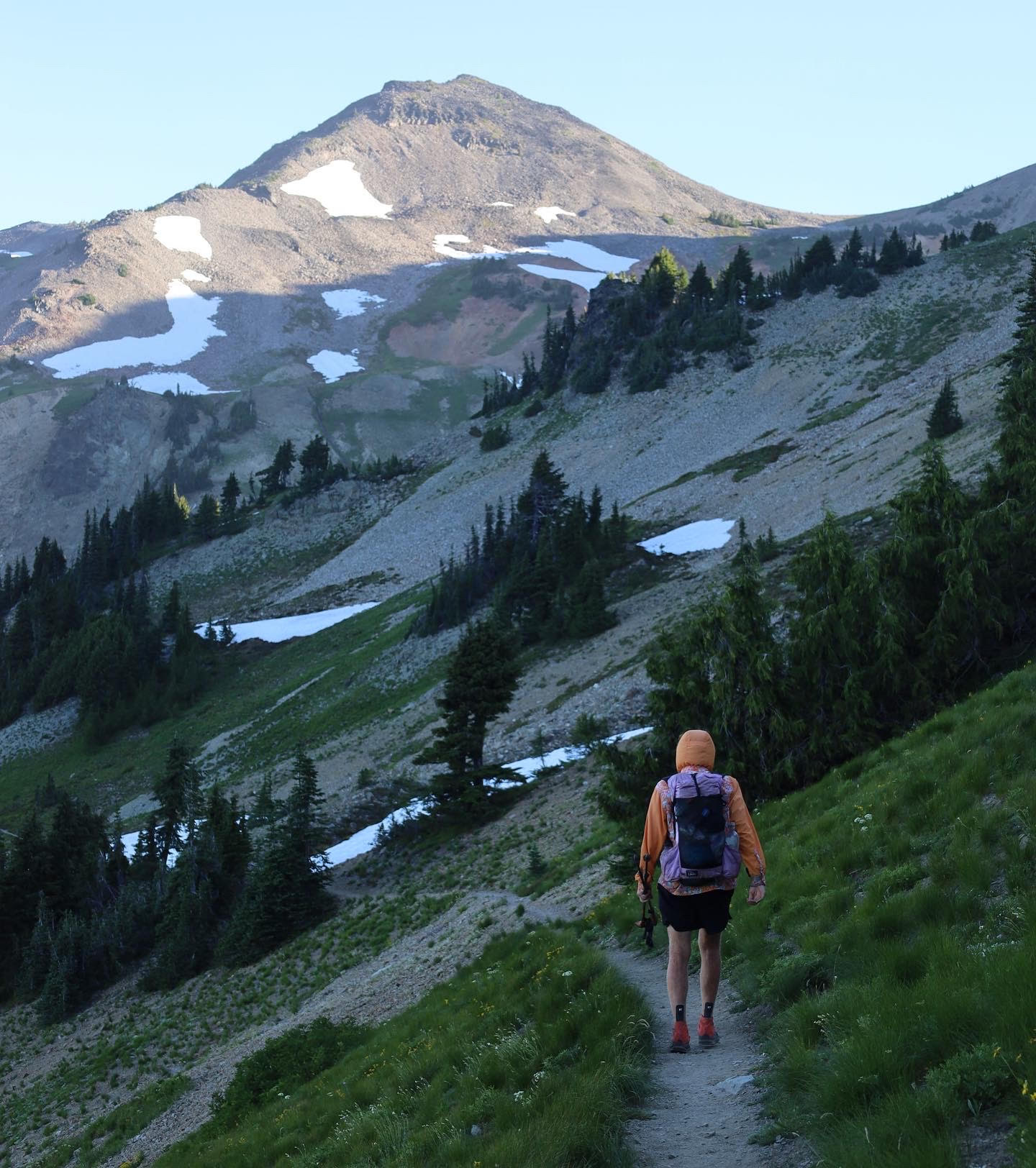Carl “Professor” Stanfield on Attempting the Most Miles Ever Hiked in One Year
Carl “Professor” Stanfield is on a mission to hike more miles in a single year than any hiker ever recorded. He’s currently in the middle of a Calendar Year Triple Crown, with substantial extra miles tacked onto the beginning and end.
Stanfield has already completed the Florida Trail, Appalachian Trail, and most of the Pacific Crest Trail. “This dream terrifies me in all the best ways, and that’s how I know I’m doing it right,” he said in a post for The Trek before embarking on this adventure. We caught up with Professor a few days before reaching the PCT northern terminus and beginning the CDT.
Interview has been edited for length and clarity.
I would love to hear a little bit more about your “calendar year triple crown and then some” itinerary.
I started January 1st in Key West. I’m trying to do all three trails border to border. I got to Amicalola March 1st and then headed out on the AT on March 2nd. And then, after Katahdin, I took the most direct route to get to Canada, which only added a little more than 80 miles. I finished up June 7.
I had a little bit of break time built in and took all of it after the AT. I had done the AT before, and I thought going back to it that it would feel a little bit easier than the first time. But it did not. It really beat me up. I had to lower mileage and was still really hurt at the end of the day. So I took 10 days off with family in Alabama in June.
I was also originally hoping to go straight through on every trail. But by the time June hit, I heard that it was a hot year for the PCT desert. So I got on on June 18 at Kennedy Meadows South and then hiked north from there. Now I’m about a week out from getting to the border. I had to skip a fire closure in Oregon. So I’ve got that and the desert left on the PCT.
Next, I’m going south on the CDT and hopefully can just go straight through there. I’m hoping to finish that in late October and then come back to clean up the PCT. The goal is to get done as early as I can before Thanksgiving and then go home and take another day or two off for Thanksgiving. Then I’ll hike the Mountains to Sea Trail starting the day after Thanksgiving through the end of the year.
You mentioned that you expected the AT to be pretty easy, and then you felt really worn down. Can you talk more about expectations versus reality on the AT?
The AT was my first thru-hike. My second thru-hike was the PCT, and I was able to raise my mileage. After time passes, you forget the difficult stuff. I thought the next time I did the AT, I could probably do it a lot faster. Then I got out there, and it was just really hard.
Also, I got to the AT having already hiked 1700 miles, so I wasn’t super fresh when I got there. The 1200 miles of Florida were totally flat. So my feet were broken in a little bit, but my climbing muscles weren’t there.
The other thing that I didn’t really plan for, that I both really enjoyed and that also slowed me down, was being able to meet up with people so much. From Key West to Canada, it took 158 days, and I spent more than half of those nights indoors. I was meeting up with people frequently, which was great for morale, but it definitely lowered my mileage. And also, I never really got into a backpacking groove until I got out West because I was rarely on trail for more than one or two nights at a time.
Are you going to be fresh going into the CDT?
The best that I can. On the AT around Damascus, I started getting Achilles tendinitis, and my heels have really been bothering me. That hasn’t gone away. Even after I took 10 days off, I was still feeling it a little bit when I got back on trail. I don’t think there’s too, too much freshness that I could acquire without taking a real long break.
How are you feeling about doing the CDT for the first time, especially compared to the AT and the PCT, both of which you’ve done before?
I’m a little nervous for it. The last five months now have felt really comfortable. Little things that I’ve remembered have made the last couple trails a lot easier to navigate. So there’s all the excitement of a new trail, and I think the beauty of being on trail is going to be really cool and really exciting. But logistically, it’ll be a little bit more difficult.
Have you mostly been resupplying in towns?
I had been pescetarian for a long time, and then I was vegan right before I got on trail. But about six months before I came out, I started eating everything again, just to make life easier on myself. I decided that one year of eating everything will be OK in the grand scheme of things. It’ll make my life so much easier. It’ll make it easier to meet up with people that might cook me a meal or to accept trail magic.
I remembered from both these trails (that) it’s pretty easy to get food. I think I’ll take the simplicity and remove the fear of having to rely on post offices, which are often closed over the weekends. But I knew I was gonna have to send myself shoes. So I bought enough food that every time I send myself shoes, I send myself a resupply package.
How have the logistics been of this much more elaborate itinerary compared to the logistics of a regular thru-hike?
I approached it the same way as the other hikes I’ve done. Last year, I mapped out every single day of this entire year: mileage per day, when I’ll be in towns and all this stuff, knowing I was definitely not going to stick to it. But I liked the practice so that when I get to sections of trail, I can remember that I had looked at this stretch before. It’s not about sticking to a plan. So much of it is just figuring things out on the fly. But I feel better doing it on the fly, having looked at it once before already when I was planning.
Do you have a sense of community on trail, or is most of the community through staying with people?
I’ve been pleasantly surprised by both. I was expecting to be a bit removed from the actual trail communities this year and to not spend too much time with people. On the AT, there was another guy that was trying to do the trail in 100 days and started February 28, just a few days before I did. I ended up hiking on and off for over half the trail with him, so I actually had a good friend out there. And then there was a small bubble of hikers that had started early. Getting out onto the PCT, I’m surprised by how crowded it’s been, and I’ve found people to hike with.
Because I’ve been on top of it with social media, I’ve gotten this cool experience of being recognized by other hikers on trail. Some days it can feel like a little bit of a hassle to explain everything that I’m doing. When people recognize me, it’s like I’ve got my introduction taken care of, and then I can spend my energy talking and getting to know them instead of having to reiterate the same things over and over again.
Have you had any negative interactions sparked by your social media?
I’ve been really shocked by how exclusively positive it’s been. I try to be positive and neutral online. I try to stay away from talking about anything political or opinions about things that are going on on trail. I’m just here to talk about hiking. I guess my following is small enough that I haven’t had big negative stuff.
What inspired you to try to break the record for most miles hiked in a calendar year?
It’s a mix of things. One of my favorite parts of the thru-hiking experience has been taking on something that I don’t know if I’m capable of. Not knowing if you can do something and then actually doing it is so satisfying and gratifying.
So I knew that I wanted to do the CDT. And I also thought that at some point, I might want to attempt a calendar year triple crown. And so I thought, “well, if I’m gonna do this, let me like take it to expert mode,” in order to take on something that I don’t know if I can do.
There’s only a certain season window you can really do the calendar year triple crown. So then I looked at what else could you hike in a year. I’d been interested in the Eastern Continental Trail and saw that I can just tack this on at the beginning and still get to the AT around when people start to do that trail. It turns out January and February are the ideal times to be in Florida. On the other end of the year, I went to college in North Carolina and have spent falls and winters out there and know that it’s cold and miserable, but I can navigate it on the Mountains to Sea Trail.
So I started putting that together and thinking, “well, if I did this, how close would this be to the most anyone’s ever done.” I did the best research I could. The only thing I could really find was Cam “Swami” Honan. He’s extremely well-traveled. He did this project maybe a decade ago called “12 Long Walks.” He spent like 17 or 18 months hiking around 15,000 miles. Part of that was a calendar year triple crown with some other stuff. It was around 10,300 miles. He said that he thought that was the most anybody had ever traveled in a year.
I also like numbers a lot. So my goal became 11,000 miles, because the average comes out to 30 miles a day, I turned 30 in December, and so it’s 30 miles a day for my 30th year of life. That also gives me a little bit of cushion, which I am going to have to take. I don’t believe that I’m on pace to hit 11,000 miles anymore. But I am on pace to hit the record.
Have you ever had any moments where you’ve either considered getting off trail or where you’ve doubted your own ability to finish this thing?
The first few days were pretty tough in Florida. I went through a depression season at the end of last year, and was gaining weight and not exercising a ton and stressed about what I had committed myself to doing. So I wasn’t super confident when I set out in Florida. In the first four days of the trip, I was just road walking through the heat in the Keys. I was getting 30 miles, but at the end of each day, I went to bed thinking, “I really don’t know if I’m going to be able to stand up in the morning.” And then I’d get a good night of sleep and get up and be able to hobble into it.
So since then, I haven’t really had any days where I’ve thought about quitting. I still genuinely want to be out here. And I’ve seen that my body has responded decently well, recovers OK, and is able to keep going. I believe that I’m still capable of doing it, and then it’s mostly just mental at this point.
Even the worst days out here are so much better than what the alternative would be: going home having thrown in the towel. I still am enjoying being out here. I just trust myself that when I’m not having the best day, it’s still overall what I want to be doing.
Do you have any mental strategies that you use when the going gets rough?
I’ve been thru-hiking enough that I really fully trust that “this too shall pass,” knowing that “this is a really tough day, but I’ll get up and I’ll feel better tomorrow.” Also, I mentioned that I’ve traded in miles to be able to meet up with people. That’s helped so much. There’s never been more than a one-week stretch where I haven’t had something to really look forward to at the end of it. So there are all these small goals and small rewards that I set up for myself along the way.
Do you have an idea of what you’re going to do after this crazy adventure?
For my first few months, I’m going to just take life really slowly. I need time to let all this sit. I’ve budgeted enough and saved up enough before this that I’m not going to feel the need to go straight back to work. I also have the privilege of having a lot of family that really loves me and really wants to see me, so I can go and spend weeks at a time with various family members, and I won’t feel in the way.
I want to put together some kind of project or write-up about all this. I carry a paper journal with me and I write every day. So I have a well-documented set of data to compile into something when I finish up.
What’s your work generally when you’re not thru-hiking full-time?
The last few years, I was working for an outdoor store in Alabama called Alabama Outdoors. I had a good time with that, but I think I’m ready for something different and maybe to live somewhere different as well. That’s also part of this, is figuring out what the next thing is, and how to integrate hiking into my life as best that I can and how to do that kind of thing sustainably.
So I’ve had time to think about that. But it’s still early enough that I don’t spend a ton of time or energy on that. I trust the process of whatever is going to come next. I want the openness that if a cool adventure or opportunity falls into my lap, I can take it. I’m not stressed about the other side.
So I saw on your other posts on The Trek that you’re a bit of a gearhead. What’s been some of your favorite gear? Have there been any disappointments?
My quilt right now is a Katabatic Flex 30. That’s been awesome. I’ve had it every single day of this year, and it’s still in pretty good shape. Katabatic is known for being a little bit conservative in their warmth ratings, so I’ve been comfortable in the 20s.

Carl “Professor” Stanfield in his Katabatic Flex 30 quilt. Photo via his review.
Then I also had an insulated sleeping pad. For the first half of the year, I had a NEMO pad before I switched to the lighter classic ThermaRest NeoAir Xlite.
I’ve gone through a couple of different packs. I put a lot of miles on my ULA Ohm that I really liked. I’m in a LiteAF pack right now that I worked with Chris over there to design.
I love my Jolly Gear shirt, you know, that are really popular this year. I’ve been in this shirt since January, and it’s holding up well.
I’m not 100% dedicated to anything. I just like having a well-rounded set of experiences with gear, so I like to switch things up and try new things because I don’t think it’s about finding the best piece of gear. I think everything that’s being made right now is so good, for the most part, that it comes down to all preference. The differences are so tiny, sometimes, and also so personal.
I would love to hear a little bit about the Florida Trail. I feel like it’s one of the National Scenic Trails that’s a bit less traveled and has a little bit of a bad reputation.
I was pretty pleased by it. I think expectations are really important for that trail. I got to the Florida Trail on January 7th. And I didn’t realize it, but they’d had a kickoff event for thru-hikers on the 3rd and 4th. So there was a small bubble of like 30 or 40 people that had all set out just a few days before I got there. I was there in the right time of the season, and it was a dry year.
They were two main swamp areas. There’s Big Cypress, and that felt so overgrown that I thought it would be difficult for gators to move through. I’m not sure if that’s true or not, but I kind of took an “ignorance is bliss” approach to that. So that was slow moving. And it was never more than knee deep. And then there was the other swamp that was up north that was messier. You couldn’t really see the bottom. And there were a lot of blowdowns, and so you’re just going blaze-to-blaze and wading through water. So it was an adventure.
I didn’t see any gators on the actual Florida Trail. I think I saw five total snakes through the whole thing. So it was way fewer scary creatures than I thought that I would see.
There’s a lot of road walking. The hikers I saw that were unhappy were the ones that were bummed there was so much road walking. But if you’ve read even a little bit on the Florida Trail, you know that’s going to be part of it. Food carries were often short because of that, because you pass gas stations during the day, so there’s perks to it.
The actual trail is pretty cool. Other than the swamp bits, the really cool stuff is flat, so you can move pretty good on it.
The physical effects of being on flat lands all the time were kind of interesting because you’re not doing different things with your muscles in your feet. They get worn a little bit differently. So I thought it’d be easier to do 40-mile days and stuff like that, but my feet were just getting really beat up in ways I wasn’t used to. I was in the maybe 30ish mile range for most of it. So the miles weren’t as easy to push as I thought they would be.
Was there anything else that you want to add?
I’ve been surprised that the heart of this has been community and interactions with people. I figured that’s what I would be sacrificing, but I’ve gotten to spend a lot of time with people on trail and off trail. It’s still all been about the community.
Follow Professor on Instagram as he continues his adventures!
All images, including featured image composite, courtesy of Carl “Professor” Stanfield.
This website contains affiliate links, which means The Trek may receive a percentage of any product or service you purchase using the links in the articles or advertisements. The buyer pays the same price as they would otherwise, and your purchase helps to support The Trek's ongoing goal to serve you quality backpacking advice and information. Thanks for your support!
To learn more, please visit the About This Site page.

 ">
">








